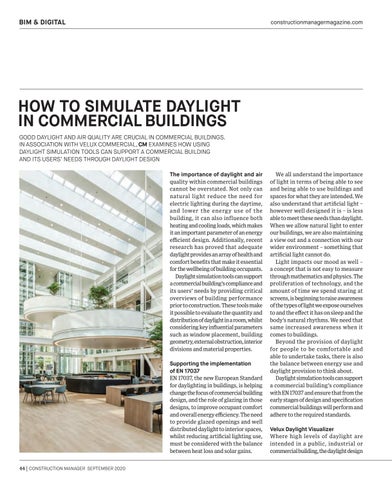BIM & DIGITAL
constructionmanagermagazine.com
HOW TO SIMULATE DAYLIGHT IN COMMERCIAL BUILDINGS GOOD DAYLIGHT AND AIR QUALITY ARE CRUCIAL IN COMMERCIAL BUILDINGS. IN ASSOCIATION WITH VELUX COMMERCIAL, CM EXAMINES HOW USING DAYLIGHT SIMULATION TOOLS CAN SUPPORT A COMMERCIAL BUILDING AND ITS USERS’ NEEDS THROUGH DAYLIGHT DESIGN The importance of daylight and air quality within commercial buildings cannot be overstated. Not only can natural light reduce the need for electric lighting during the daytime, and lower the energy use of the building, it can also influence both heating and cooling loads, which makes it an important parameter of an energy efficient design. Additionally, recent research has proved that adequate daylight provides an array of health and comfort benefits that make it essential for the wellbeing of building occupants. Daylight simulation tools can support a commercial building’s compliance and its users’ needs by providing critical overviews of building performance prior to construction. These tools make it possible to evaluate the quantity and distribution of daylight in a room, whilst considering key influential parameters such as window placement, building geometry, external obstruction, interior divisions and material properties. Supporting the implementation of EN 17037 EN 17037, the new European Standard for daylighting in buildings, is helping change the focus of commercial building design, and the role of glazing in those designs, to improve occupant comfort and overall energy efficiency. The need to provide glazed openings and well distributed daylight to interior spaces, whilst reducing artificial lighting use, must be considered with the balance between heat loss and solar gains.
We all understand the importance of light in terms of being able to see and being able to use buildings and spaces for what they are intended. We also understand that artificial light – however well designed it is – is less able to meet these needs than daylight. When we allow natural light to enter our buildings, we are also maintaining a view out and a connection with our wider environment – something that artificial light cannot do. Light impacts our mood as well – a concept that is not easy to measure through mathematics and physics. The proliferation of technology, and the amount of time we spend staring at screens, is beginning to raise awareness of the types of light we expose ourselves to and the effect it has on sleep and the body’s natural rhythms. We need that same increased awareness when it comes to buildings. Beyond the provision of daylight for people to be comfortable and able to undertake tasks, there is also the balance between energy use and daylight provision to think about. Daylight simulation tools can support a commercial building’s compliance with EN 17037 and ensure that from the early stages of design and specification commercial buildings will perform and adhere to the required standards. Velux Daylight Visualizer Where high levels of daylight are intended in a public, industrial or commercial building, the daylight design
44 | CONSTRUCTION MANAGER SEPTEMBER 2020
44_45.CMSept20velux_scW.indd 44
18/08/2020 15:19























